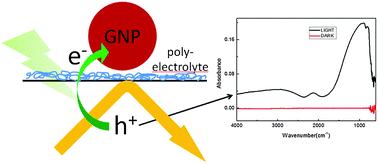-
Mapping Infrared Enhancement around Gold Nanoparticles Using Polyelectrolytes
H. Ghosh and T. Bürgi
The Journal of Physical Chemistry C, 121 (4) (2017), p2355-2363


DOI:10.1021/acs.jpcc.6b10613 | unige:94059 | Abstract | Article HTML | Article PDF | Supporting Info
Enhancement of infrared signals from polyelectrolyte adsorbed on gold nanoparticles (GNPs) was studied in situ by attenuated total reflection infrared spectroscopy. Nanoparticles and polyelectrolytes were deposited using layer-by-layer techniques, and the infrared signal was studied as a function of particle size, particle density, and distance from particle surface. It was observed that enhancement is more pronounced for larger nanoparticles and it decreases with increasing distance from the particle surface. Furthermore, at high GNP coverage, the signal from the first polyelectrolyte layer is particularly enhanced, and the signal increases slowly with time, in contrast to subsequent layers. We assign this to polyelectrolyte adsorption within narrow gaps between nanoparticles, where the electric field is enhanced. Furthermore, enhanced absorption was observed in the gap between the GNPs and the germanium internal reflection element, which was confirmed by polarized measurements. This enhancement is more pronounced for silver particles, and it represents a promising route for analysis of surfaces by infrared spectroscopy.

